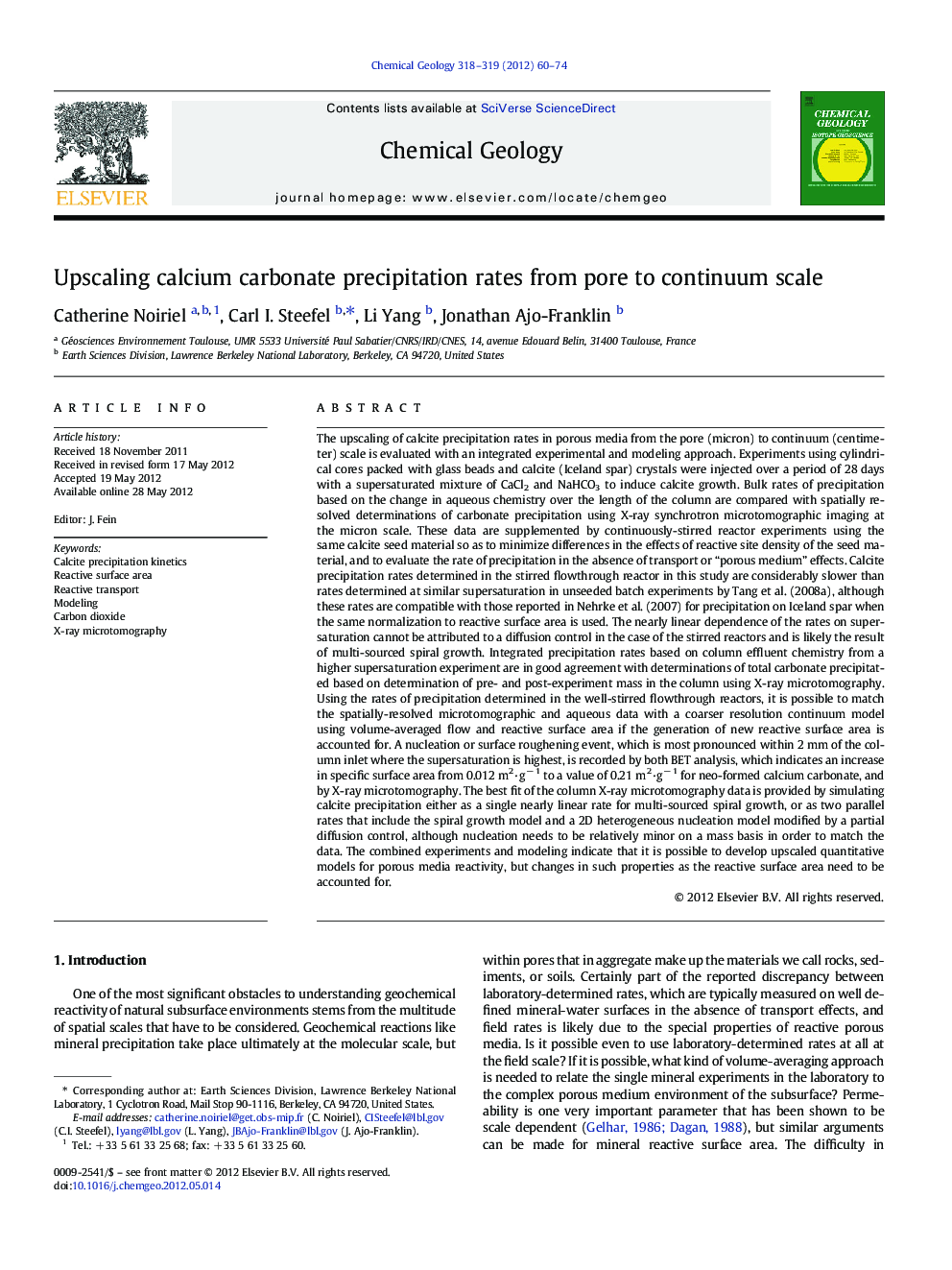| کد مقاله | کد نشریه | سال انتشار | مقاله انگلیسی | نسخه تمام متن |
|---|---|---|---|---|
| 4699383 | 1637642 | 2012 | 15 صفحه PDF | دانلود رایگان |

The upscaling of calcite precipitation rates in porous media from the pore (micron) to continuum (centimeter) scale is evaluated with an integrated experimental and modeling approach. Experiments using cylindrical cores packed with glass beads and calcite (Iceland spar) crystals were injected over a period of 28 days with a supersaturated mixture of CaCl2 and NaHCO3 to induce calcite growth. Bulk rates of precipitation based on the change in aqueous chemistry over the length of the column are compared with spatially resolved determinations of carbonate precipitation using X-ray synchrotron microtomographic imaging at the micron scale. These data are supplemented by continuously-stirred reactor experiments using the same calcite seed material so as to minimize differences in the effects of reactive site density of the seed material, and to evaluate the rate of precipitation in the absence of transport or “porous medium” effects. Calcite precipitation rates determined in the stirred flowthrough reactor in this study are considerably slower than rates determined at similar supersaturation in unseeded batch experiments by Tang et al. (2008a), although these rates are compatible with those reported in Nehrke et al. (2007) for precipitation on Iceland spar when the same normalization to reactive surface area is used. The nearly linear dependence of the rates on supersaturation cannot be attributed to a diffusion control in the case of the stirred reactors and is likely the result of multi-sourced spiral growth. Integrated precipitation rates based on column effluent chemistry from a higher supersaturation experiment are in good agreement with determinations of total carbonate precipitated based on determination of pre- and post-experiment mass in the column using X-ray microtomography. Using the rates of precipitation determined in the well-stirred flowthrough reactors, it is possible to match the spatially-resolved microtomographic and aqueous data with a coarser resolution continuum model using volume-averaged flow and reactive surface area if the generation of new reactive surface area is accounted for. A nucleation or surface roughening event, which is most pronounced within 2 mm of the column inlet where the supersaturation is highest, is recorded by both BET analysis, which indicates an increase in specific surface area from 0.012 m2·g− 1 to a value of 0.21 m2·g− 1 for neo-formed calcium carbonate, and by X-ray microtomography. The best fit of the column X-ray microtomography data is provided by simulating calcite precipitation either as a single nearly linear rate for multi-sourced spiral growth, or as two parallel rates that include the spiral growth model and a 2D heterogeneous nucleation model modified by a partial diffusion control, although nucleation needs to be relatively minor on a mass basis in order to match the data. The combined experiments and modeling indicate that it is possible to develop upscaled quantitative models for porous media reactivity, but changes in such properties as the reactive surface area need to be accounted for.
► Upscaling of mineral precipitation rates from the pore to continuum scale.
► X-ray microtomography to quantify integrated precipitation rates.
► Stirred reactor data for precipitation rates compared to porous medium rates.
► Quantification of partial diffusion control on reaction rates.
► Demonstrate importance of modeling reactive surface area evolution.
Journal: Chemical Geology - Volumes 318–319, 15 July 2012, Pages 60–74